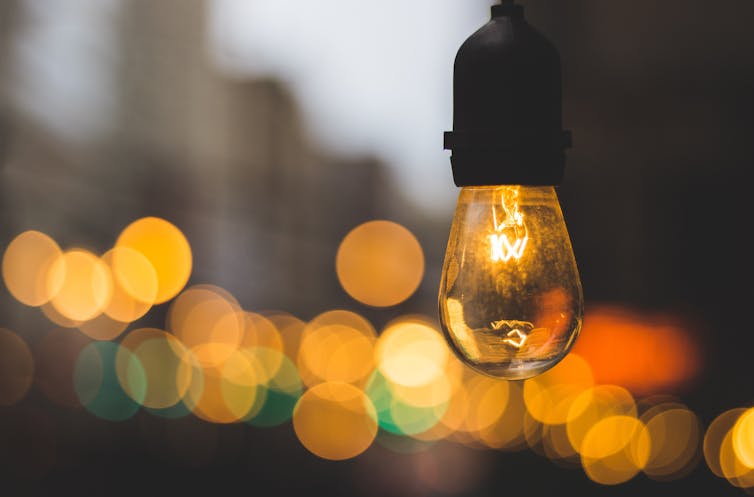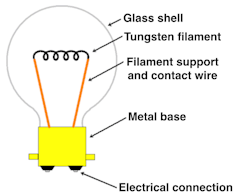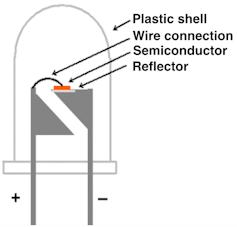

Roger Clarke, University of Bradford
Why does the light turn on? – Ben, aged three, UK.
The electric light was invented more than 200 years ago, and has been in common use for over a century. It works by converting electricity into light (and a bit of heat).
The two most common electric lights in use today are incandescent lights (which are the oldest) and light emitting diodes (LEDs). The word “incandescent” refers to something that’s so hot it glows white.

Incandescent lights have an outer shell made of glass, which has all the air sucked out of it.
Inside this vacuum, there’s a thin coiled wire called a “filament”, made of a metal called tungsten.
The glass shell has to have all the air removed so that the tungsten doesn’t rust away or “oxidise” when it gets hot.

Curious Kids is a series by The Conversation, which gives children the chance to have their questions about the world answered by experts. If you have a question you’d like an expert to answer, send it to curiouskids@theconversation.com. We won’t be able to answer every question, but we’ll do our very best.
Tungsten is used in light bulbs because it has a really high melting point (over 3,000°C), which is much higher than the temperature needed to give a nearly white light (2,000°C).
Heating up
These types of light bulbs are now mostly used in vehicles and low cost pocket torches because they are cheap and reliable. But they also make a lot of heat – in fact, it’s only by getting very hot that they can light up at all – and this is seen as being wasteful of energy.
When the light bulb is connected to a source of electricity, the electricity can easily travel along the thick wires to the light bulb. But when it reaches the filament, with its very thin wire, the electricity has to force its way through, using up a lot of energy which makes the filament very hot, and very bright.
The more energy used by the incandescent light, the brighter it will be. The amount is usually written on the side of the light bulb; for example 20 watts, 40 watts and so on.
Lighting the way
In modern houses, schools and workplaces, the incandescent light has mostly been replaced with LED lights. This is because they use much less energy – about one sixth – to make the same amount of light, since they don’t really get hot. LEDs can also last a very long time, compared to other lights.

The way that LED lights work is not actually very different to the way incandescent lights work.
But instead of heating up a wire to produce the white light, an LED light has a special material inside it called a “semiconductor” to produce the light.
The particular type of semiconductor in an LED reacts when an electric current is passed through it by a process called electrolumincescence and this gives out lots of light, but not very much heat.
LEDs can be made to produce light in almost any colour, by changing the chemicals in the semiconductor.
Children can have their own questions answered by experts – just send them in to Curious Kids, along with the child’s first name, age and town or city. You can:
- email curiouskids@theconversation.com
- tweet us @ConversationUK with #curiouskids
- DM us on Instagram @theconversationdotcom
Here are some more Curious Kids articles, written by academic experts:
-
Can we live on Kepler 452-b? – Year Five, Globe Primary School, London, UK.
-
When fish get thirsty do they drink sea water? – Torben, aged nine, Sussex, UK.

Roger Clarke, Honorary Visiting Senior Research Fellow, University of Bradford
This article is republished from The Conversation under a Creative Commons license. Read the original article.






